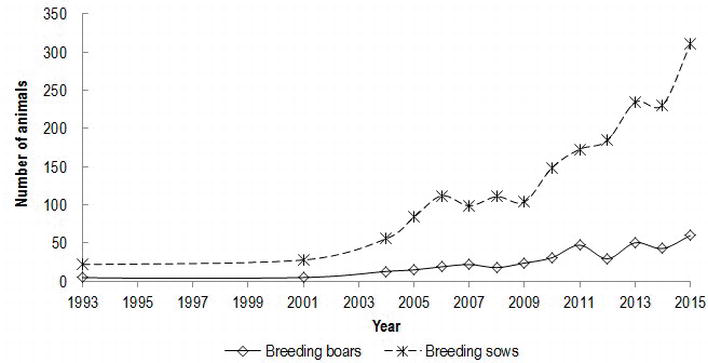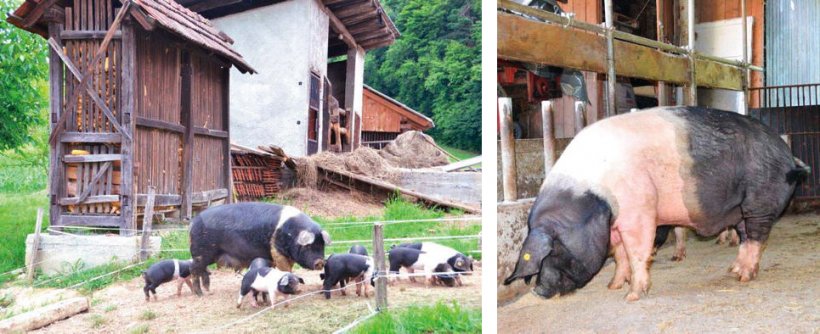History and the current status of the breed
Slovenia has only one preserved indigenous local pig breed, the Krškopolje pig (in Slovenian, Krškopoljski prašič). The oldest known record about Krškopolje pig dates back to the year 1899 when Rohrman described a widespread pig production in Dolenjska region, especially in the area of Krško polje (Krško is the name of the town and “polje” means field in Slovenian). In the old literature, Krškopolje pig was also named the black-belted, belted or striped pig. The breed became endangered due to official campaign against Krškopolje pig in the 1960s; consequently, the last official records about the breed and fertility data were reported in 1972 before its revival in the early 1990s of the twentieth century when in situ gene bank was implemented [1]. In that time around 40 farms were still raising Krškopolje pigs [2]. Promotion and support for organic farming along with the subsidies for the use of Krškopolje pig increased the interest for the breed. After the year 2003, when individual marking of all newborn piglets was introduced, the interest for breeding the Krškopolje pigs has increased. Census of the Krškopolje pig breed is presented in Figure 1. Presently, there are 130 registered farms of the Krškopolje pigs with about 311 breeding sows and 60 boars in the latest available status (August 2015). However, the breeders have on average only one to two sows.


Exterior phenotypic characteristics
The Krškopolje pig breed morphology information is summarised in Table 1. It is a middle to large sized breed of black coat colour and a characteristic continuous white belt across the shoulders and forelegs (Figures 2 and 3). The head is medium sized, with looped ears of medium length. The face should be slightly dished and the nose top white. The body is wide and not too deep, the back is long, wide and straight, the shoulders are strong and medium in width, and the hams are broad, full and long. The hair is strong, straight and dark over the pigmented parts of the body. Their temperament is calm.
Table 1. Summary of morphology information on the Krškopolje pig breed.
| Measurement (average) | Adult male | Adult female |
|---|---|---|
| Body weight (kg) | 280 | 230 |
| Body length1(cm) | 152 | 140 |
| Height at withers (cm) | 87 | 83 |
| Number of teats (average) | - | 14 |
1 Measured from the tip of the nose to the starting point of the tail.

Geographical location and production system
The origin of the Krškopolje pig is geographically located in the south-east part of the Dolenjska region, the area of Krško-Brežiško field and the foothills of Gorjanci hills. However, nowadays farms with the Krškopolje pigs are distributed throughout Slovenia. The breed is adapted to poor rearing conditions, is robust and efficiently uses the forage; thus, it can be kept outdoors. Traditionally, the Krškopolje pigs were kept in a mixed production system—with indoor housing and access to outdoor area. Indoor housing was usually in pens with the full floor and straw bedding or deep litter. Water and feed were provided twice per day (morning and late afternoon) in wooden troughs. Pigs were fed with locally available seasonal ingredients that were usually pre-cooked in large kettles. The feed mixture was composed of seasonal vegetable (e.g. carrots, turnips, beets, cabbage and potatoes), cereals (barley, oats, wheat, triticale, buckwheat and millet) and residual food from the household. Sometimes, skimmed milk or whey was added. Additionally, fresh grass or clover in spring and summer and grass or alfalfa hay in winter was provided through the day. Nowadays, animals of the Krškopolje pig breed are being reared in various production systems: from more intensive indoor system with conventional feed mixture to fully outdoor system where pigs are fed with various crops and kept on pasture. They are provided a shelter in case of unfavourable weather conditions and are moved indoor only in strong winter.
Productive performance
Reproductive traits
The age of sows at the first parturition is around 14 months (12–16 months) denoting the age at which sows reach a target weight of 100 kg when they are usually mated for the first time is to some extent later than in intensively kept modern breeds. The breed has moderately good fertility. On average sows of the Krškopolje pig breed have 1.8 litters per year with between 8.1 and 10.5 piglets of approximately 1.2 kg live body weight. Stillborn percentage of piglets is very variable and ranges between 5.7 and 21.9%. However, regarding the fact that piglet mortality in loose farrowing systems commonly ranges from 20–33%, which is about twofold greater than that normally occurring in confinement farrowing crates, mortality at weaning in the considered studies of Krškopolje is satisfactory (8.1 to 26.7%). Duration of lactation is prolonged in comparison to modern intensive systems (to approximately 44 days), which leads to a longer farrowing interval (between 187 and 240 days) and consequently a lower number of piglets produced per sow per year (16.9). On average sows have 5.6 litters in their lifetime, which corresponds to results obtained in modern breeds.
Growth performance
In the considered studies, daily gain in the early growing stage, which corresponds to lactation period (195–355 g/day), is in the range of values described for leaner breeds. However, it should be taken into account that the lactation period (approximately 44 days) is considerably greater than in sows of conventional breeds (21–28 days). Average daily gain in the growing stage (between 207 and 385 g/day) is lower than in modern breeds, which denotes lower intensity of rearing. Also, the early, middle, late and overall fattening stages are generally characterised by slower growth and big heterogeneity (355–934, 352–968, 533–1085 and 352–951 g/day in early, middle, late and overall growing stage, respectively), related to the fact that this review comprises studies where different systems and feeding levels were practised. In the context of the evaluation of growth performance, it is also of interest to observe the extreme values, because it can be assumed that the maximum figures exhibit the growth potentials of Krškopolje pigs in ad libitum conditions of feeding (≈951 g/day in overall fattening stage).
Average daily feed intake increased from 1.1 kg/day in growing stage to max 3.2 kg/day in the late fattening stage when semi ad libitum feeding regime was applied.

Body composition and carcass traits
In considered studies, pigs were slaughtered at approximately 276 days of age, between 88 and 146 kg, i.e. an average 118 kg live weight. Dressing yield was around 77% and lean meat content around 44% (39.7 to 47.8%; SEUROP classification or dissection). The backfat thickness values measured on the withers spanned from 45 to 67 mm, at the level of the last rib from 22 to 49 mm and at the level of gluteus medius muscle from 33 to 44 mm. Muscularity measured as loin eye area varied from 23 to 42 cm2 and muscle thickness measured at the cranial edge of gluteus medius muscle from 49 to 69 mm, which indicates lower muscular development in the Krškopolje pig compared to modern breeds. This variation in backfat and muscle thickness is also a consequence of the wide range of the final live weight (88 to 146 kg) of pigs and different feeding regimes applied in considered studies.
Meat quality
In the few studies reporting meat quality of Krškopolje pigs, pH values measured in longissimus muscle at 45 min and 24 h post-mortem were around 6.08 and 5.47, respectively. Relatively low average value of pH 45 in the considered studies could be an indicator of a higher presence of an RYR1 mutation in the Krškopolje pig breed. pH 24 values in the considered studies are somewhat higher than in modern breeds, which is indicative of lower glycogen stores before slaughter. This corroborates with higher intramuscular fat content (2.0–4.3%), both indicative of more oxidative muscle metabolism. In agreement with this, colour measurements (Minolta L value; L* = 48 to 52 confirm a bit more intensive colour of meat. In the considered studies, SFA, MUFA and PUFA contents were approximately 36, 48 and 16% for intramuscular fat in longissimus muscle and approximately 39, 48 and 14% for backfat tissue. Due to big differences between studies concerning the feeding regime, feed composition, final body weight and fatness, which are all important factors influencing the fatty acid composition of meat, it is difficult to interpret the results on the fatty acid composition. Nevertheless, it can be concluded that the results obtained from the considered studies indicate a higher proportion of MUFA and SFA in Krškopolje pigs and lower PUFA content in comparison to the modern meaty type of pigs.
Use of breed and main products
The Krškopolje pig is intended for production of high-quality meat and fat. Pigs are raised in poorer conditions, with less concentrated feeds and with additional fibre feed. The breed is prone to fat deposition, but meat contains relatively high content of intramuscular fat, which makes it tastier. It is suitable for roasted pork or preparation of traditional dried products (e.g. salami, sausages, dry cured hams and pancetta).
Full text and references are available here: Krškopolje Pig.
Nina Batorek Lukač, Urška Tomažin, Martin Škrlep, Andrej Kastelic, Klavdija Poklukar and Marjeta Čandek-Potokar (February 6th 2019). Krškopoljski prašič (Krškopolje Pig), European Local Pig Breeds - Diversity and Performance. A study of project TREASURE, Marjeta Candek-Potokar and Rosa M. Nieto Linan, IntechOpen, DOI: 10.5772/intechopen.83767. Available from: https://www.intechopen.com/books/european-local-pig-breeds-diversity-and-performance-a-study-of-project-treasure/kr-kopoljski-pra-i-kr-kopolje-pig



